BISAC NAT010000 Ecology
BISAC NAT045050 Ecosystems & Habitats / Coastal Regions & Shorelines
BISAC NAT025000 Ecosystems & Habitats / Oceans & Seas
BISAC NAT045030 Ecosystems & Habitats / Polar Regions
BISAC SCI081000 Earth Sciences / Hydrology
BISAC SCI092000 Global Warming & Climate Change
BISAC SCI020000 Life Sciences / Ecology
BISAC SCI039000 Life Sciences / Marine Biology
BISAC SOC053000 Regional Studies
BISAC TEC060000 Marine & Naval
The purpose of this study is to propose a hypothesis of a multistage management model for coastal areas consisting of Satoumi and Satoumi-network, referring to case studies. Satoumi, which is a type of Coastal Management, has been increasing from the 2000s in Japan. As Satoumi is mainly created and managed by local residents and local governments, its activities is called a bottom-up approach. Through this study, we could follow the developing processes and changing organizations. For example, in Hinase, activities for seagrass bed conservation and enhancement have been carried out since 1985. As a result, the range of seagrass bed has increased dramatically and the management organization has become including diverse sectors of the region. So we can call these activities a whole of region approach. On the other hand, Satoumi cannot cover wider coastal areas like a prefecture jurisdiction and provide coastal infrastructure like water quality regulations and coast protecting facilities. Such coastal infrastructure should be provided by prefecture governments as ICM through integrated and top-down management process. In Omura Bay, the Nagasaki prefecture government has established such a management system. Whole projects relating to Omura Bay are to be collected and adjusted through its management process. So I’d like to call this a whole of government approach. Unfortunately, this system is not good at networking voluntary activities by local residents. In Kagawa Prefecture, to resolve this weakness, an intermediary activities are provided by the Kagawa prefecture government. The government has established “Kagawa Satoumi Creating Vision” whose main theme is to connect and network relating activities. It is called a support providing approach or intermediating approach. These three approaches are mutually complement to achieve a total system for Coastal Management. Therefore, I’d like to propose a multistage management model consisting of three components; Satoumi, Satoumi network and coastal infrastructure, and three approaches; a whole of region approach, a whole of government approach and a support providing approach.
Satoumi, ICM.
- Introduction
The importance of a coastal area has been emphasized since the 1990s and it’s been becoming the common sense all over the world. In Japan, although Integrated Coastal Management (ICM) supported institutionally has not been introduced widely yet, Satoumi initiative [1] as a voluntary ICM has been increasing. According to our questionnaire research, the number of Satoumi initiative is estimated as 232 cases in Japan [2].
Through case studies as follows, it becomes clear that Satoumi initiatives challenge to resolve the tragedy of the commons by making regional rules and the prefecture governments try to integrate the vertically separated government, and also three different approaches are found. Then, I will organize these approaches to the total system as a multistage management model.
- Governance Structure of Coastal Management
Before main story, let’s organize a legal situation of Coastal Management (CM) in Japan. As indicated at Fig.1, sea and beach is a national property. Therefore no one can own them privately. On the other hand, there is no integrated coastal management institution. However, there are various individual institutions like the port laws and the beach construction law. As a result, the divided government on vertical separation becomes a problem. It will be a common challenge how to integrate such a divided government. On the other hand, aquatic resources like fish are ownerless property. It means anyone can utilize these resources freely. It will easily cause the tragedy of the commons. It will be the next common challenge to resolve the tragedy of the commons.
Fig.1. Complexity of ownership on a coastal area in Japan
Users of a coastal sea are also various and include many stakeholders. It means that we have to think co-management with various stakeholders. To do so, I employ the governance layer structure model. Fig.2 indicates the standard layer structure as an example of the fisheries management. There is a governance layer structure from governments to users, which is separated into three layers; a central government, a local government and users. And also there is a responsibility sharing among then as same as the government layer.
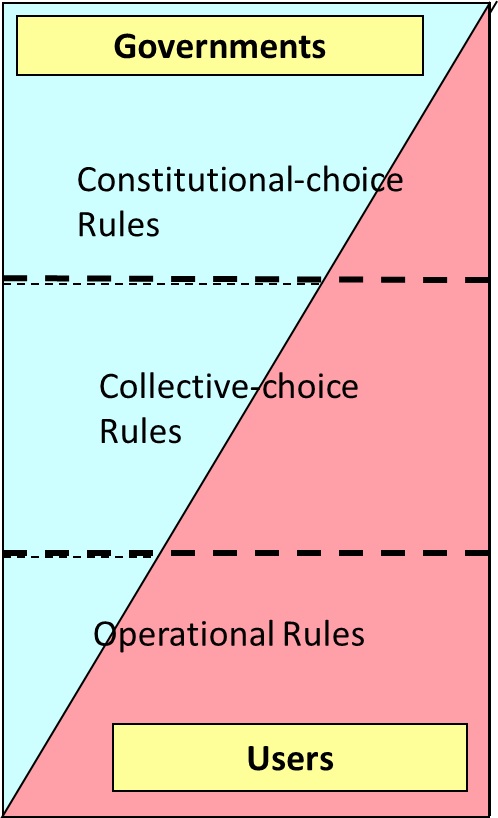
Fig.2. Governance Structure of Fisheries Management
Table 1 explains a content of the governance layer structure for CM, adjusting to Fig.2. In this table, a government is separated into three layers; a central government, a prefecture government and a municipality government. Each line means the roles and functions of each management body concerning CM. The first and second lines mean coastal infrastructures including facilities and institutions provided by governments. Then the third and fourth lines are concerning to Satoumi management. For suitable CM as “wise use”, the each layers must not only be managed well, but also four layers have to be combined well. To check them, I have organized case studies as follows.
Table 1. Governance structure of Coastal Management
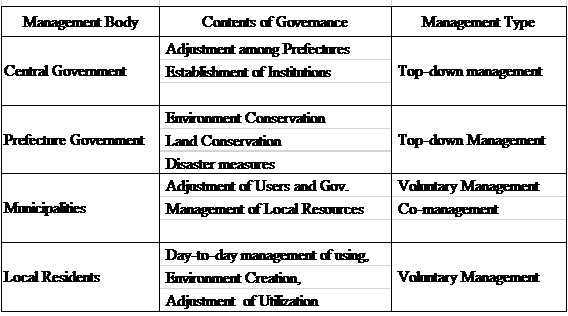
- Case STUDIES
The cases which I have studies are located at Fig.3. The horizontal axis is a range of targeting area separated into four levels; local area, municipality area, prefecture area and over prefecture area. The vertical axis is a diversity of utilization separated into three levels; single-phase, double-phase and multi- phase.
The simplest case, which means utilization is only one type (e.g. fishery) and the range is limited in a local area, is located at the lower left corner. While the cases become more complex, the cases are located at the more upper and right side. The most complicated case is ICM in the wider area like the Chesapeake Bay and the Seto Inland Sea. I’d like to call this movement a dynamics of Coastal Management development.
Saying the conclusion first, each case has a different management system individually and cases at the same range of targeting area have a common governance. So I’d like to call a family of governance at the same range a layer. When we observe the management structure, we have to think compiled layers structure depending on the range of targeting area. This is the core idea consisting of a multistage management model.
Hereafter, let’s look at each cases.
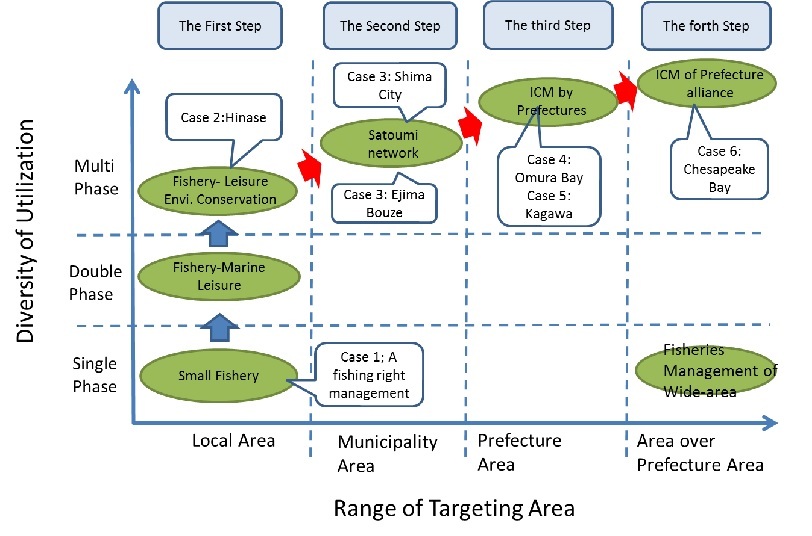
Fig.3. Dynamics of ICM Development
Case 1
Fig.4 shows the organizational arrangement of the case at the lower left corner of Fig.3. This indicates the scene that a fishing community manages the coast in front of the community concerning fisheries and fishing resources. Such a traditional and indigenous management will be observed commonly throughout the world.
In Japan, this system has been institutionalized as a fishing right system. Under the present legal scheme in Japan, Fisherman’s Cooperative Association (FCA) as a representative of a fishing community is granted a fishing right by a prefecture government and manages the fishing right ground as an authority. The FCA does not only set up fishing rules, but also encourages measures to preserve the environment and fishing resources within the designated fishing right ground. Members of the FCA can fish collectively and exclusively under strict management rules provided by the FCA. The essence of this system is as same as the traditional commons [3], which can maintain the commons sustainably. So we can say that a fishing right management is a proto type of traditional Satoumi.
If other conditions were same, the fishing right management should have been Satoumi management as sustainable CM. However, many social surroundings have changed. Many and various users coming into a fishing right ground, this system has become not be able to maintain the rules and the environment of the fishing ground as before. In many case, FCA forms a new community to resolve the problems, responding to the new situation.
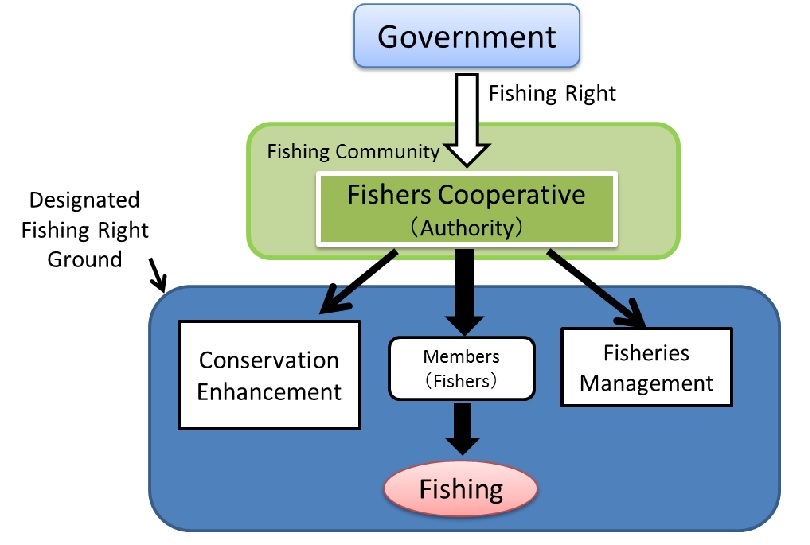
Fig.4. Fishing Right Ground Management by Fishing CommunitiesFig.4. Fishing Right Ground Management by Fishing Communities
Case 2
Next, let’s look at a new community to responding a new situation. Fig. 5 explains the organization arrangement of Hinase, which is located at the Seto Inland Sea, as an example. The fishers of Hanase FCA started to protect and enhance a seagrass bed voluntarily in 1985. Since then, this activity has been continued with participating many and various stakeholders, and has resulted in expanding the area of a seagrass bed and improving the coastal environment. At the first stage, this activity had been carried out by fishers of Hinase FCA. Then, various stakeholders participating gradually, the Integrated Coastal Management Committee at Hinase was established supported by local governments as Fig.5. As most people concerned at the Hinase district are involved in this organization, I’d like to call this activity “a whole of region approach”. This committee takes charge of rule-making, monitoring and adjustment concerning the coastal area. As a result, it is thought that this organization and approach will be an ideal community for Satoumi management.
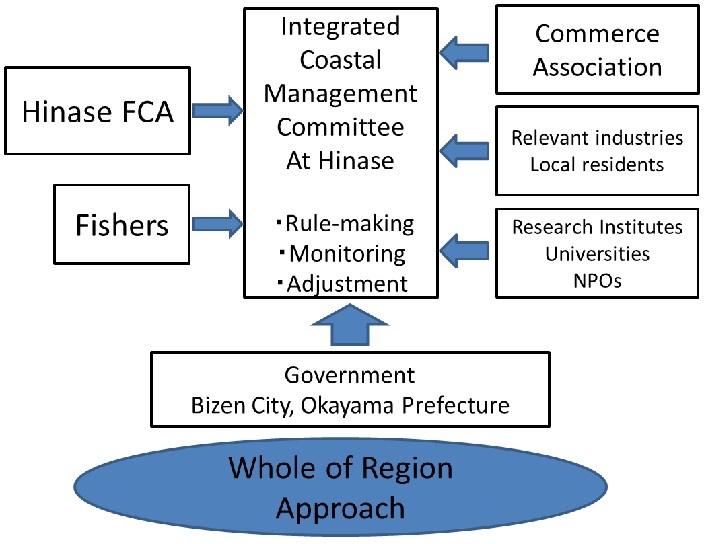
Fig.5. Joint management between stakeholders and governments
According to the case studies until now, we can say that the essence of this new community is to be a network organization which members are connecting with weak ties [4]. Because of this characteristic, a network organization can be a leaning organization and have an ability of value creation as illustrated at Fig.6. To function as such a network organization, suitable governance and intermediating are needed. Particularly, secretaries have a significant role as an intermediating organization.
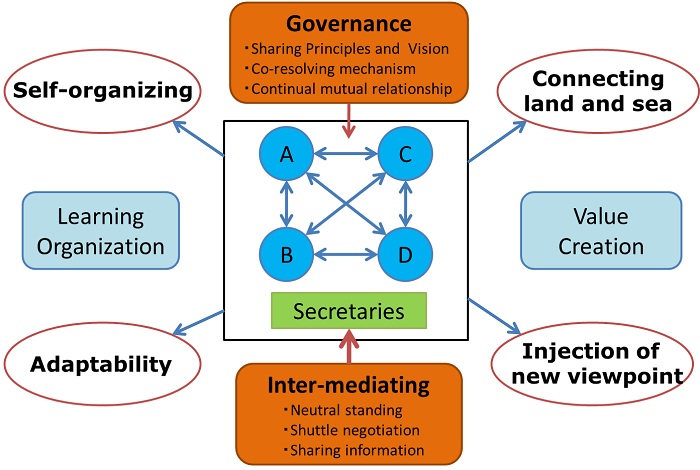
Fig.6. Network Organization of Satoumi Management
Case 3
Satoumi which has a new community and efficient secretaries as mentioned above is suitable for a small area with homogeneous utilization. However, it can’t cover a wider area which becomes heterogeneous. In that case, if some Satoumi responding to the situation of each coast are networked, the wider area will be covered. This is the idea of Satoumi networking. Fig.7 indicates the actual example of Satoumi networking in Shima City, where there are three types of a coastal area. The city government tries to create three Satoumi responding to each conditions and network them through the organizational arrangement indicated at Fig.7. Particularly, Shima City Satoumi Creation Promoting Committee has a significant role as an intermediator.
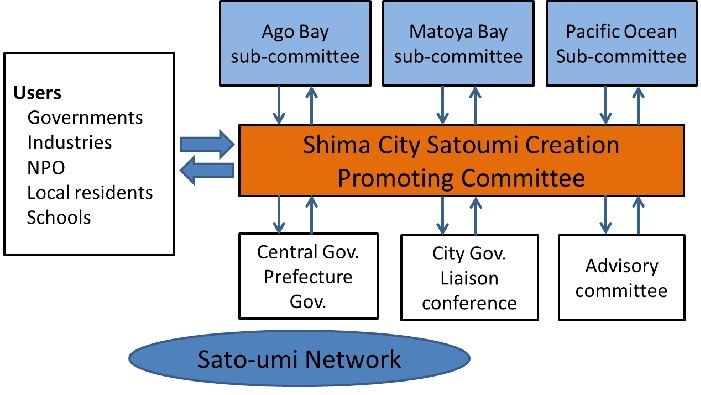
Fig.7. Management Organization networking plural Satoumi
Such Satoumi network is observed at other places. For example, there is the MPA network around Ejima Bouze Island in the Seto inland sea. The FCA set up the MPA cooperating with the Hyogo prefecture government and leisure fishers, and is planning to set up other three MPAs and connect them around the island.
Case 4
As coastal infrastructure is complicated, various government sections are related to it. Therefore, it becomes a challenge how to integrate the vertical sectionalism. Furthermore, a government has to cover wider areas than small Satoumi’s area. Concerning coastal infrastructure, the management body is mainly a prefecture government. The point is how to integrate the prefecture organization and manage a whole of the prefecture territory.
In Omura Bay at Nagasaki Prefecture, the prefecture government has established the management plan; Omura Bay Environment Conservation and Revitalization Plan, to recover Omura Bay’s environment and industries in 2003. To carry out the plan, the government has formed a management organization and process as indicated at Fig. 8. The most outstanding characteristic is that whole of relevant government divisions concerning Omura Bay combine at the organization and whole projects are put together into the plan. Furthermore, the plan and each projects are managed by utilizing the PDCA (Plan, Do, Check, Act) cycle. As this case includes whole of relevant government divisions and has a rational management process, I’d like to call it “a whole of government approach” [5]. The total achievement of the plan is to be measured by the indicators of Chemical Oxygen Demand (COD), Total Nitrogen (TN) and Total Phosphate (TP). This approach is thought to be effective to integrate the vertical separation of a government.
Unfortunately, this process is not good at involving non-governmental and municipality’s activities. Although the organization arrangement includes networking with such activities, there is little measure to support them and link relevant activities. For example, there is no support measures for small Satoumi managed by local residents or non-profit organizations.
Such Satoumi network can cover a wider area, but can’t provide coastal infrastructure like environmental regulations and facility construction. These are the governmental jurisdictions. Next, let’s look at the government cases.
Case 4
As coastal infrastructure is complicated, various government sections are related to it. Therefore, it becomes a challenge how to integrate the vertical sectionalism. Furthermore, a government has to cover wider areas than small Satoumi’s area. Concerning coastal infrastructure, the management body is mainly a prefecture government. The point is how to integrate the prefecture organization and manage a whole of the prefecture territory.
In Omura Bay at Nagasaki Prefecture, the prefecture government has established the management plan; Omura Bay Environment Conservation and Revitalization Plan, to recover Omura Bay’s environment and industries in 2003. To carry out the plan, the government has formed a management organization and process as indicated at Fig. 8. The most outstanding characteristic is that whole of relevant government divisions concerning Omura Bay combine at the organization and whole projects are put together into the plan. Furthermore, the plan and each projects are managed by utilizing the PDCA (Plan, Do, Check, Act) cycle. As this case includes whole of relevant government divisions and has a rational management process, I’d like to call it “a whole of government approach” [5]. The total achievement of the plan is to be measured by the indicators of Chemical Oxygen Demand (COD), Total Nitrogen (TN) and Total Phosphate (TP). This approach is thought to be effective to integrate the vertical separation of a government.
Unfortunately, this process is not good at involving non-governmental and municipality’s activities. Although the organization arrangement includes networking with such activities, there is little measure to support them and link relevant activities. For example, there is no support measures for small Satoumi managed by local residents or non-profit organizations.
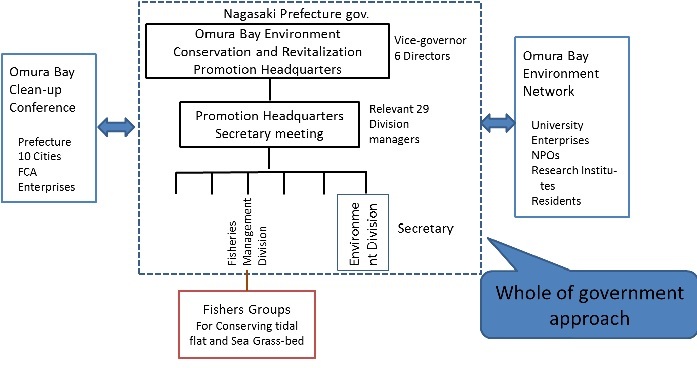
Fig.8. Management Organization by top-down approach combining whole of
relevant government divisions
Case 5
The next case at Kagawa Prefecture is challenging these weakness of Omura Bay management. The prefecture government has established the management plan; The Vision of Kagawa Satoumi Creating in 2014, to improve the environment of a coastal sea along the Seto Inland Sea. The purpose of this plan is to provide support to private activities and link relevant entities or measures together. To do so, there are some projects to support and link private activities to protect the coastal environment. Furthermore, a project to link relevant measures is also promoted. Because of such support measures, I’d like to call this “a support providing approach” or “an intermediating approach”.
The weakness of this case is that there is no specific management organization to integrate the vertical separation of the government. Of course, there is a management organization to promote this plan. However, the organizational mechanism to beyond the vertical separation is weak, compared to the case of Omura Bay.
As you notice, while of government approach and support providing approach are mutually complementary. It seems that each strength complements each weakness.
- Complex of three management approaches
Organizing the case studies, I’d like to propose a multistage management model as a hypothesis. Until now, I have mentioned each layer based on each range of targeting area; local area, municipality area and prefecture area through the case studies. Then, we could extract three approaches; a whole of region approach, a whole of government approach and a support providing approach. Here, I have to combine them all as a total system. Let’s locate each layers and approaches at the governance structure shown at Fig.2. A whole of government approach providing coastal infrastructure is located at the upper left corner, and a whole of region approach is at the opposite side. Both two approaches are combined by a support providing approach. A whole of region approach consists of Satoumi and Satoumi network. These governance structure is explained at Fig. 9. As this model includes the governance of a prefecture government, a municipality government and local residents, it can conform the governance structure explained at Table 1 and cover a prefecture area.
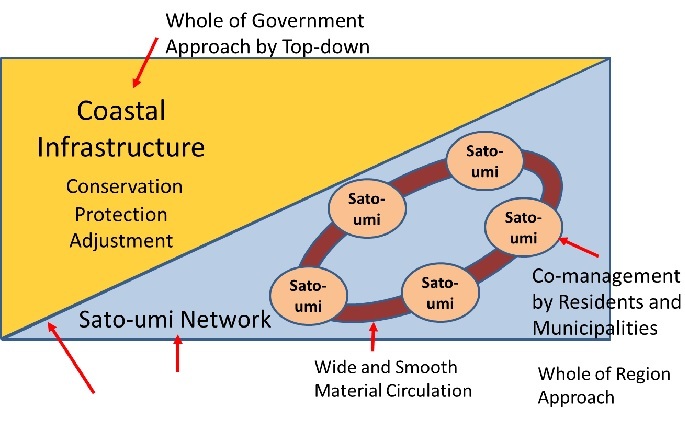
Fig.9. Combination of whole of government approach and whole of region approach through support providing approach
When a targeting area is beyond a prefecture area like the Seto Inland Sea, an alliance of relevant prefectures will be affective. Relevant prefectures don’t integrate the management systems and targeting areas into the one system and one area, but form an alliance concerning providing coastal infrastructure. On the other hand, Satoumi and Satoumi network is promoted individually depending to each situation. Similar case is observed at the Chesapeake Bay Program [6]. In the Chesapeake Bay (case 6), where there are 6 states and DC, they cooperate through an agreement moderately and manage each coastal area independently. Even in the Seto Inland Sea, such an alliance among relevant prefectures should be possible based on the Law Concerning Special Measures for Conservation of the Environment of the Seto Inland Sea, which has just amended. In that case, a role of the central government to adjust prefecture governments will become more important.
- Discussion
We have picked up three activities and three approaches through the case studies. They were individually proved to be effective but insufficient as a management system for CM. So I have proposed to integrate them as a whole system. That is a multistage management model. The essence is the combination of different management approaches adapting to the different range of targeting areas and the different governance layers. With regards to a double stage management scheme, many researchers have advocated its effectiveness in Japan [7]. However, the detail of the management system has not been explained yet. This multistage management model indicates the detail.
Until now, it has been argued that one single system has to be adapted to manage a coastal area as ICM in Japan. That is ICM. However, it is not necessarily one system, but may be a single system as a whole. In Japan, there are a lot of and various experience of CM. Such an experience may be compiled sophisticatedly through this model.
The challenge of this model is to be difficult to prove the effectiveness, because there is no exact case which has adapted this yet. The only way will be to carry out the action research method at any prefecture.
- Acknowledgment
This work was supported by JSPS KAKENHI Grant-in-Aid for Scientific Research(C), Grant Numbers JP25340151 and the Environment Research and Technology Development Fund (S13, 4(2)) of the Ministry of the Environment, Japan.
1. T. Yanagi, Sato-umi: a new concept for coastal sea management, Tokyo: Terrapub, 2007.
2. T. Hidaka, A study of the structure and function of the Sato-umi management organization:preliminary analysis through questioner surveys, Journal of Coastal Zone Studies, vol.28 No.3, 2015, pp. 107-118.
3. E. Ostrom, Governing the Commons: The Evolution of Institutions for Collective Action, Cambridge: Cambridge University Press, 1990.
4. N. Wakabayasi, Network organizations, Tokyo, Yuhikaku, 2009.
5. M. Bevir, Governance: A Very Short Introduction, Oxford: Oxford University Press, 2012.
6. J. Nagamine, Watershed Management and the Efforts in the Chesapeake Bay Program, Journal of Policy Studies, No.24, 2006, pp. 69-94.
7. T. Hidaka, A Study on the Management System of Integrated Coastal Management: Effectiveness of Dual Management Systems and Network Governance, Journal of Japan Society of Ocean Policy, vol.5, 2014, pp. 61-72.








